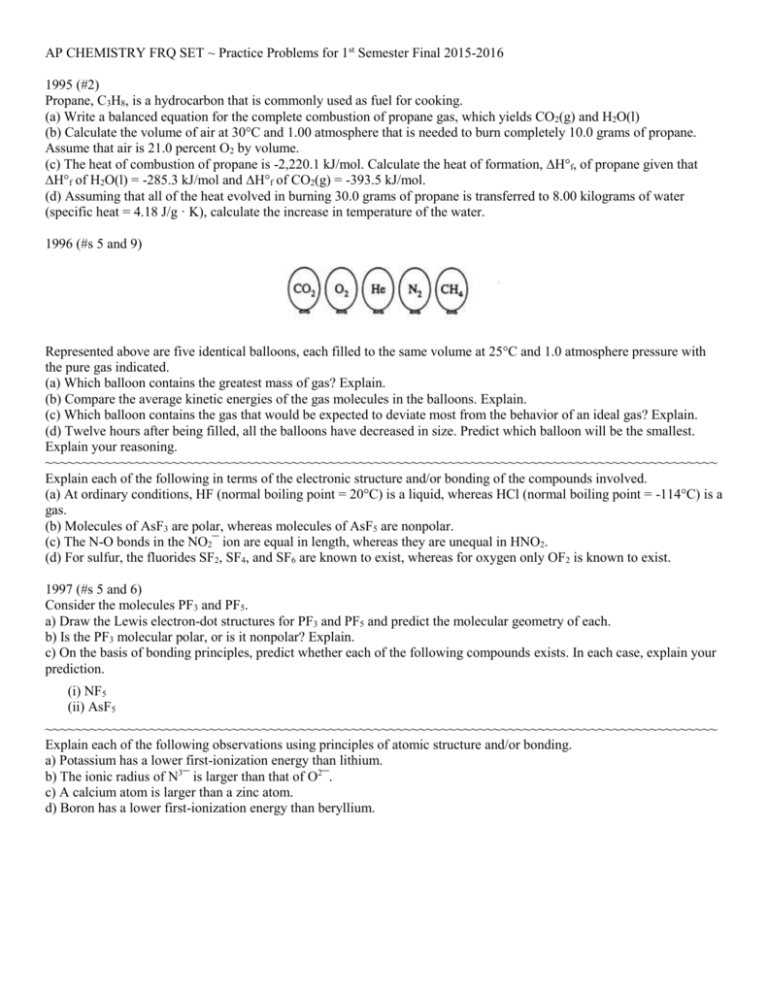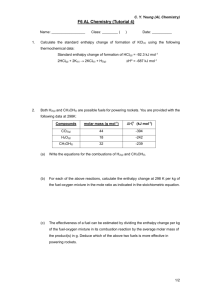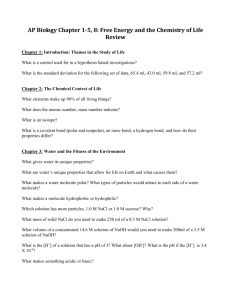AP Chemistry 1st Semester Final ~ FRQ Practice
advertisement

AP CHEMISTRY FRQ SET ~ Practice Problems for 1st Semester Final 2015-2016 1995 (#2) Propane, C3H8, is a hydrocarbon that is commonly used as fuel for cooking. (a) Write a balanced equation for the complete combustion of propane gas, which yields CO2(g) and H2O(l) (b) Calculate the volume of air at 30°C and 1.00 atmosphere that is needed to burn completely 10.0 grams of propane. Assume that air is 21.0 percent O2 by volume. (c) The heat of combustion of propane is -2,220.1 kJ/mol. Calculate the heat of formation, ∆H°f, of propane given that ∆H°f of H2O(l) = -285.3 kJ/mol and ∆H°f of CO2(g) = -393.5 kJ/mol. (d) Assuming that all of the heat evolved in burning 30.0 grams of propane is transferred to 8.00 kilograms of water (specific heat = 4.18 J/g · K), calculate the increase in temperature of the water. 1996 (#s 5 and 9) Represented above are five identical balloons, each filled to the same volume at 25°C and 1.0 atmosphere pressure with the pure gas indicated. (a) Which balloon contains the greatest mass of gas? Explain. (b) Compare the average kinetic energies of the gas molecules in the balloons. Explain. (c) Which balloon contains the gas that would be expected to deviate most from the behavior of an ideal gas? Explain. (d) Twelve hours after being filled, all the balloons have decreased in size. Predict which balloon will be the smallest. Explain your reasoning. ~~~~~~~~~~~~~~~~~~~~~~~~~~~~~~~~~~~~~~~~~~~~~~~~~~~~~~~~~~~~~~~~~~~~~~~~~~~~~~~~~~~~~~~~~~ Explain each of the following in terms of the electronic structure and/or bonding of the compounds involved. (a) At ordinary conditions, HF (normal boiling point = 20°C) is a liquid, whereas HCl (normal boiling point = -114°C) is a gas. (b) Molecules of AsF3 are polar, whereas molecules of AsF5 are nonpolar. (c) The N-O bonds in the NO2¯ ion are equal in length, whereas they are unequal in HNO2. (d) For sulfur, the fluorides SF2, SF4, and SF6 are known to exist, whereas for oxygen only OF2 is known to exist. 1997 (#s 5 and 6) Consider the molecules PF3 and PF5. a) Draw the Lewis electron-dot structures for PF3 and PF5 and predict the molecular geometry of each. b) Is the PF3 molecular polar, or is it nonpolar? Explain. c) On the basis of bonding principles, predict whether each of the following compounds exists. In each case, explain your prediction. (i) NF5 (ii) AsF5 ~~~~~~~~~~~~~~~~~~~~~~~~~~~~~~~~~~~~~~~~~~~~~~~~~~~~~~~~~~~~~~~~~~~~~~~~~~~~~~~~~~~~~~~~~~ Explain each of the following observations using principles of atomic structure and/or bonding. a) Potassium has a lower first-ionization energy than lithium. b) The ionic radius of N3¯ is larger than that of O2¯. c) A calcium atom is larger than a zinc atom. d) Boron has a lower first-ionization energy than beryllium. 1998 (#3) C6H5OH(s) + 7 O2(g) → 6 CO2(g) + 3H2O(l) When a 2.000-gram sample of pure phenol, C6H5OH(s), is completely burned according to the equation above, 64.98 kilojoules of heat is released. Use the information in the table below to answer the questions that follow. Substance C(graphite) CO2(g) H2(g) H2O(l) O2(g) C6H5OH(s) f, at 25°C (kJ/mol) 0.00 -395.5 0.00 -285.85 0.00 ? Absolute Entropy, S°, at 25°C (J/mol-K) 5.69 213.6 130.6 69.91 205.0 144.0 (a) Calculate the molar heat of combustion of phenol in kilojoules per mole at 25°C. H°f, of phenol in kilojoules per mole at 25°C. (c) Calculate the value of the standard freeG° for the combustion of phenol at 25°C. (d) If the volume of the combustion container is 10.0 liters, calculate the final pressure in the container when the temperature is changed to 110°C. (Assume no oxygen remains unreacted and that all products are gaseous.) 1999 (#s7 and 8) Answer the following questions, which refer to the 100 mL samples of aqueous solutions at 25°C in the stoppered flasks shown below. a. Which solution has the lowest electrical conductivity? Explain. b. Which solution has the lowest freezing point? Explain. c. Above which solution is the pressure of water vapor greatest? Explain. d. Which solution has the highest pH? Explain. ~~~~~~~~~~~~~~~~~~~~~~~~~~~~~~~~~~~~~~~~~~~~~~~~~~~~~~~~~~~~~~~~~~~~~~~~~~~~~~~~~~~~~~~~~~ Answer the following questions using principles of chemical bonding and molecular structure. Consider the carbon dioxide molecule, CO2 , and the carbonate ion, CO32-. a. Draw the complete Lewis electron-dot structure for each species. b. Account for the fact that the carbon-oxygen bond length in CO32- is greater than the carbon-oxygen bond length in CO2. Consider the molecules CF4 and SF4. c. Draw the complete Lewis electron-dot structure for each molecule. d. In terms of molecular geometry, account for the fact that the CF4 molecule is nonpolar, whereas the SF4 molecule is polar. 2000 (#6) Consider the reaction represented by: O3(g) + NO(g) O2(g) + NO2(g) a) Referring to the data in the table below, calculate the standard enthalpy change, ΔHo, for the reaction at 25 C. Be sure to show your work. o O3(g) 143 NO(g) 90. NO2(g) 33 Standard Enthalpy of formation, ΔHfo, at 25 o C (kJ mol-1) b) Make a qualitative prediction about the magnitude of the standard entropy change, ΔSo, for the reaction at o 25 C. Justify your answer. c) On the basis of your answers to parts a) and b), predict the sign of the standard free-energy change, ΔGo, for the reaction at 25 oC. Explain your reasoning. d) Use the information in the table below to write the rate-law expression for the reaction, and explain how you obtained your answer 2001 (#s 2 and 8) The reaction represented below is one that contributes significantly to the formation of photochemical smog. 2 NO(g) + O2(g) 2 NO2(g) ΔHo = -114.1 kJ, ΔSo = -146.5 J K-1 a) Calculate the quantity of heat released when 73.1 g of NO(g) is converted to NO2(g). b) For the reaction at 25 oC, the value of the standard free-energy change, ΔGo, is –70.4 kJ. i. Calculate the value of the equilibrium constant, Keq, for the reaction at 25 oC. ii. Indicated whether the value of ΔGo would become more negative, less negative, or remain unchanged as the temperature is increased. Justify your answer. c) Use the data in the table below to calculate the value of the standard molar entropy, So, for O2(g) at 25 oC. NO(g) NO2(g) Standard Molar Entropy, So (J K-1 mol-1) 210.8 240.1 d) Use the data in the table below to calculate the bond energy, in kJ mol-1, of the nitrogen-oxygen bond in NO2. Assume that the bonds in the NO2 molecule are equivalent (i.e., they have the same energy). Bond Energy (kJ mol-1) Nitrogen-oxygen bond in NO 607 Oxygen-oxygen bond in O2 495 Nitrogen-Oxygen bond in NO2 ? ~~~~~~~~~~~~~~~~~~~~~~~~~~~~~~~~~~~~~~~~~~~~~~~~~~~~~~~~~~~~~~~~~~~~~~~~~~~~~~~~~~~~~~~~~~ Account for each of the following observations about pairs of substances. In your answers, use appropriate principles of chemical bonding and/or intermolecular forces. In each part, your answer must include references to both substances. a) b) c) d) Even though NH3 and CH4 have similar molecular masses, NH3 has a much higher normal boiling point (-33 oC) than CH4 (-164 oC). At 25 oC and 1.0 atm, ethane (C2H6) is a gas and hexane (C6H14) is a liquid. Si melts at a much higher temperature (1,410 oC) than Cl2 (-101 oC). MgO melts at a much higher temperature (2,852 oC) than NaF (993 oC). 2002 (#5) 1. H+(aq) + OH-(aq) H2O(l) A student is asked to determine the molar enthalpy of neutralization, Hneut, for the reaction represented above. The student combines equal volumes of 1.0 M HCl and 1.0 M NaOH in an open polystyrene cup calorimeter. The heat released by the reaction is determined by using the equation q = mcT. Assume the following. Both solutions are at the same temperature before they are combined. The densities of all the solutions are the same as that of water. Any heat lost to the calorimeter or to the air is negligible. The specific heat capacity of the combined solutions is the same as that of water. a.) Give appropriate units for each of the terms in the equation q = mcT. b.) List the measurements that must be made in order to obtain the value of q. c.) Explain how to calculate each of the following. a. The number of moles of water formed during the experiment. b. The value of the molar enthalpy of neutralization, Hneut, for the reaction between HCl(aq) and NaOH(aq). d.) The student repeats the experiment with the same equal volumes as before, but this time uses 2.0 M HCl and 2.0 M NaOH. i. Indicate whether the value of q increases, decreases, or stays the same when compared to the first experiment. Justify your prediction. ii. Indicate whether the value of the molar enthalpy of neutralization, Hneut, increases, decreases, or stays the same when compared to the first experiment. Justify your prediction. e.) Suppose that a significant amount of heat were lost to the air during the experiment. What effect would this have on the calculated value of the molar enthalpy of neutralization, Hneut? Justify your answer. 2003 (#s 7 and 8) Answer the following questions that relate to the chemistry of nitrogen. a. Two nitrogen atoms combine to form a nitrogen molecule, as represented by the following equation 2N(g) N2 (g) Using the table of average bond energies below, determine the enthalpy change, ΔH, for the reaction. Bond Average Bond Energy (kJ mol-1) N–N 160 N=N 420 N≡N 950 The reaction between nitrogen and hydrogen to form ammonia is represented below. N2(g) + 3 H2(g) 2 NH3(g) ΔHo = - 92.2 kJ b. Predict the sign of the standard entropy change, ΔSo, for the reaction. Justify your answer. c. The value of ΔGo for the reaction represented in part (b) is negative at low temperatures but positive at high temperatures. Explain. d. When N2(g) and H2(g) are placed in a sealed container at a low temperature, no measurable amount of NH3(g) is produced. Explain. ~~~~~~~~~~~~~~~~~~~~~~~~~~~~~~~~~~~~~~~~~~~~~~~~~~~~~~~~~~~~~~~~~~~~~~~~~~~~~~~~~~~~~~~~~~ Using the information in the table, answer the following questions about organic compounds. Compound Name Compound Formula ΔHvapo (kJ mol-1) Propane Propanone 1-propanol a. CH3CH2CH3 CH3COCH3 CH3CH2CH2OH 19.0 32.0 47.3 For propanone, i. draw the complete structural formula (showing all atoms and bonds) ii. predict the approximate carbon-to-carbon-to-carbon bond angle. b. For each pair of compounds below, explain why they do not have the same value for their standard heat of vaporization, ΔHvapo. (You must include specific information about both compounds in each pair.) i. ii. c. d. propane and propanone propanone and 1-propanol Draw the complete structural formula for an isomer of the molecule you drew in part a. i. Given the structural formula for propyne below, i. ii. indicate the hybridization of the carbon atom indicated by the arrow in the structure above; indicate the total number of sigma (σ) bonds and the total number of pi (π) bonds in the molecule. 2005 Form B (#7) Answer the following questions about thermodynamics. Substance Combustion Reaction H2(g) C(s) CH3OH(l) H2(g) + ½ O2(g) H2O(l) C(s) + O2(g) CO2(g) a) b) c) d) e) Enthalpy of Combustion, ΔHocomb, at 298 K (kJ mol-1) -290 -390 -730 In the empty box in the table above, write a balanced chemical equation for the complete combustion of one mole of CH3OH(l). Assume products are in the standard states at 298 K. Coefficients do not need to be whole numbers. On the basis of your answer to part a) and the information in the table, determine the enthalpy change for the reaction C(s) + H2(g) + H2O(l) CH3OH(l). Write the balanced chemical equation that shows the reaction that is used to determine the enthalpy of formation of one mole of CH3OH(l). Predict the sign of ΔSo for the combustion of H2(g). Explain your reasoning. On the basis of bond energies, explain why the combustion of H2(g) is exothermic. 2006 (#2) CO(g) + 1 O (g) CO2(g) 2 2 The combustion of carbon monoxide is represented by the equation above. (a) Determine the value of the standard enthalpy change, H rxn , for the combustion of CO(g) at 298 K using the following information. C(s) + 1 O (g) CO(g) 2 2 H 298 = 110.5 kJ mol1 H 298 = 393.5 kJ mol1 C(s) + O2(g) CO2(g) (b) Determine the value of the standard entropy change, Srxn , for the combustion of CO(g) at 298 K using the information in the following table. S298 Substance (J mol1 K1) CO(g) 197.7 CO2(g) O2(g) 213.7 205.1 (c) Determine the standard free energy change, Grxn , for the reaction at 298 K. Include units with your answer. (d) Is the reaction spontaneous under standard conditions at 298 K ? Justify your answer. (e) Calculate the value of the equilibrium constant, Keq , for the reaction at 298 K. 2008 (#s 5 and 6) Using principles of atomic and molecular structure and the information in the table below, answer the following questions about atomic fluorine, oxygen, and xenon, as well as some of their compounds. a) b) c) d) Atom First Ionization Energy (kJ mole-1) F O Xe 1681.0 1313.9 ? Write the equation for the ionization of atomic fluorine that requires 1681.0 kJ mol-1. Account for the fact that the first ionization energy of atomic fluorine is greater than that of atomic oxygen. (You must discuss both atoms in your response.) Predict whether the first ionization energy of atomic xenon is greater than, less than, or equal to the first ionization energy of atomic fluorine. Justify your prediction. Xenon can react with oxygen and fluorine to form compounds such as XeO3 and XeF4. Draw the complete Lewis electron dot diagram for each of the molecules represented below. XeO3 XeF4 e) On the basis of the Lewis electron dot diagrams you drew for part d, predict the following i) the geometric shape of the XeO3 molecule ii) the hybridization of the valence orbitals of xenon in XeF4 f) Predict whether the XeO3 molecule is polar or nonpolar. Justify your prediction. ~~~~~~~~~~~~~~~~~~~~~~~~~~~~~~~~~~~~~~~~~~~~~~~~~~~~~~~~~~~~~~~~~~~~~~~~~~~~~~~~~~~~~~~~~~ Answer the following questions by using principles of molecular structure and intermolecular forces. a) Structures of the pyridine molecule and the benzene molecule are shown below. Pyridine is soluble in water, whereas benzene is not soluble in water. Account of the difference in solubility. You must discuss both of the substances in your answer. H H C C C H H C C H Benzene H C H H Structures of the dimethyl ether molecule and the ethanol molecule are shown below. The normal boiling point of dimethyl ether is 250 K, whereas the normal boiling point of ethanol is 351 K. Account for the difference in boiling points. You must discuss both of the substances in your answer. H H Dimethyl ether c) C C C Pyridine H b) H C N C H C H H O C H H H Ethanol H H C C H H O H SO2 melts at 201 K, whereas SiO2 melts at 1883 K. Account for the difference in melting points. You must discuss both of the substances in your answer. e) The normal boiling point of Cl2(l) (238 K) is higher than the normal boiling point of HCl(l) (188 K). Account for the difference in normal boiling points based on the types of intermolecular forces in the substances. You must discuss both of the substances in your answer. 2012 (#5) Process ΔHo (kJ/molrxn) Br2(l) Br2(g) 30.91 I2(s) I2(g) 62.44 At 298 K and 1 atm, the standard state of Br2 is a liquid, whereas the standard state of I2 is a solid. The enthalpy changes for the formation of Br2(g) and I2(g) from these elemental forms at 298 K and 1 atm are given in the table above. a) Explain why ΔHo for the formation of I2(g) from I2(s) is larger than ΔHo for the formation of Br2(g) from Br2(l). In your explanation identify the type of particle interactions involved and a reason for the difference in magnitude of those interactions. b) Predict which of the two processes shown in the table has the greater change in entropy. Justify your prediction. c) I2(s) and Br2(l) can react to form the compound IBr(l). Predict which would have the greater molar enthalpy of vaporization, IBr(l) or Br2(l). Justify your prediction. An experiment is preformed to compare the solubilities of I2(s) in different solvents, water and hexane (C6H14). A student adds 2 mL of H2O and 2 mL of C6H14 to a test tube. Because H2O and C6H14 are immiscible, two layers are observed in the test tube. The student drops a small, purple crystal of I2(s) into the test tube, which is then corked and inverted several times. The C6H14 layer becomes light purple, while the H2O layer remains virtually colorless. d) Explain why the hexane layer is light purple while the water layer is virtually colorless. Your explanation should reference the relative strengths of interactions between molecules of I2 and the solvents H2O and C6H14, and the reasons for the differences. e) The student then adds a small crystal of KI(s) to the test tube. The test tube is corked and inverted several times. The I- ion reacts with I2 to form the I3- ion, a linear species. i) In the box below, draw the complete Lewis electron-dot diagram for the I3- ion. ii) In which layer, water or hexane, would the concentration of I3- be higher? Explain.





